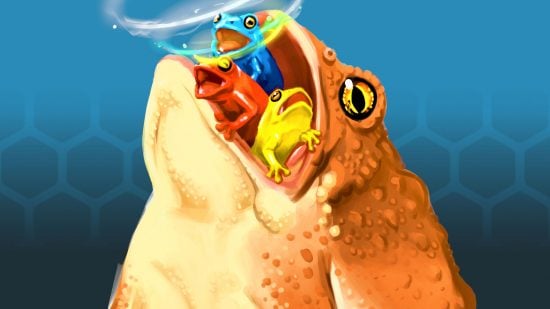Howl of the Wild, the latest Pathfinder book announced by publisher Paizo, adds a bestiary of new creatures to the world of Golarion. Senior designer and project lead James Case tells Wargamer many of the new monsters are inspired by “the wondrous things animals can do in real life”. He also gave us a sneak peek at three of the book’s most colourful critters – the Prism Hydra, the Concert Frog, and the Spellsong Lyrebird.
Case describes Howl of the Wild as “a nature documentary slash adventure novel”. Through the narrations of a naturalist and his eccentric adventuring crew, readers will be introduced to all sorts of birds and beasts. The sourcebook also features plenty of new player options, including spells, feats, archetypes, and new Pathfinder ancestries.
The first new monster Case introduces us to is currently being called the Prism Hydra. It shares the key features of a regular Hydra (regenerating heads, for example), but it’s also “a byproduct of magical experimentation […], which has unfortunately given it new abilities”.
“Each one of its heads has associations with different energy types and can shift in and out of each”, Case tells Wargamer. “Whereas with a normal Hydra, you can stop it from regenerating by burning or cauterising the stumps [of decapitated heads], this one is a lot more difficult to deal with as each of the heads is constantly changing abilities.”
The Concert Frog is based on a species of frog that raises their young in their mouths. “The Concert Frog is a large frog with little froglets in its mouth, and they harmonise to create songs that create various effects”, Case says. “The songs might have effects on the players, or they might help the Concert Frog get away from predators.”
And finally, there’s the Spellsong Lyrebird. “Actual Lyrebirds can imitate a wide variety of sounds,” Case explains, “everything from other birds to the sound of construction equipment”. “The Spellsong Lyrebird is very intelligent, and it’s learned to imitate other sounds – which has unfortunately included the incantations of nearby Pathfinder Wizards.” This means birds can now cast spells, too.
“In first edition, animals were kind of a basic creature type”, Case adds. “They could attack, they could pounce, or they could rend. But they didn’t have many advanced tactics.” “One of the cool things I think this [the Lyrebird] shows off about Pathfinder 2e is that ‘normal’ animals can do lots of really bizarre things”, he tells Wargamer.
Case gave us a few hints at other creatures we’ll be able to spot on a Howl of the Wild safari. Existing monster types like sharks and dinosaurs (and yes, frogs) have been expanded. There’ll certainly be some companion options for the player that befriends any furry thing that moves.
And there are even more weird creations to come. When asked about the strangest creatures in Howl of the Wild, Case reveals the book features a creature that acts as public transport. We can also expect to meet a well-meaning yet irritating beastie that eats gold. “ It’s a great example of a creature that’s quite cute and isn’t acting out of malice, but it might be a problem for players to interact with”, Case tells Wargamer.
Howl of the Wild is a long way off yet, with the release date expected to land somewhere in 2024. Case points out some details about these creatures may change – their core essence will be the same, but details may be tweaked in the sourcebook’s final version.
We don’t know exactly when Howl of the Wild will release, but until then, Paizo says it’ll have more to share on the book at Paizo Con Online 2023. You can also learn more about its contents in our full Howl of the Wild preview and Paizo’s announcement post. If you’re looking to play some Pathfinder now, here are some helpful guides to Pathfinder classes and Pathfinder races.



